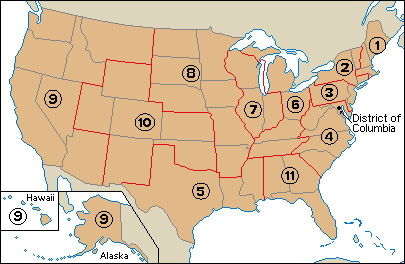Court of appeals is a high federal or state court. The United States Courts of Appeals rank next to the Supreme Court of the United States as a reviewing authority. Several of the states also have courts of appeals.

The U.S. Courts of Appeals hear most appeals from district courts and federal administrative agencies. They also review the decisions of some agencies. In some cases, the party who feels wronged has a right to appeal directly to the Supreme Court of the United States. In a few cases, the parties have a right to ask the Supreme Court to review a decision of a court of appeals. But in most cases, the Supreme Court only reviews cases that it decides present an important question of law.
In the early days of the United States, federal judges traveled from place to place to try cases and to hear appeals. The route which was assigned to the court was called the circuit. Today the circuits are geographical areas. Each circuit has one court of appeals.
The circuits are numbered 1 through 11. A twelfth, unnumbered circuit covers only the District of Columbia. The First Circuit includes Puerto Rico, the Third includes the Virgin Islands, and the Ninth includes Alaska and Hawaii. The judges of the First, Third, and Ninth Circuits travel to these places to hear cases. A special U.S. Court of Appeals for the Federal Circuit has nationwide jurisdiction. It specializes in cases involving patents and claims against the federal government.
Only three judges ordinarily sit to decide each case, though more than three judges are assigned to each circuit. A justice of the Supreme Court is assigned to each circuit as the Circuit Justice. In early times, the justice often helped decide cases at the court of appeals level, but now this rarely occurs. The chief judge has a position on the court of appeals like that of the chief justice of the Supreme Court. The chief judge assigns tasks to the other judges.
